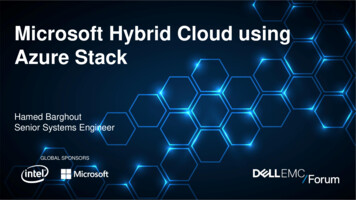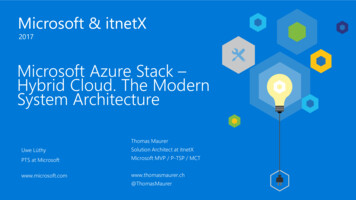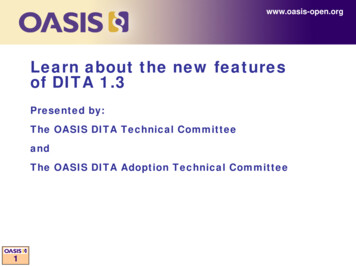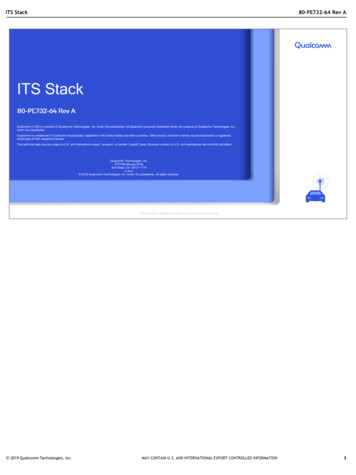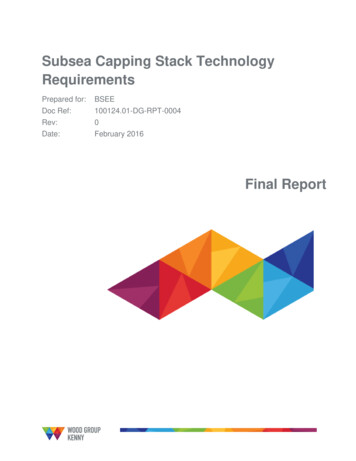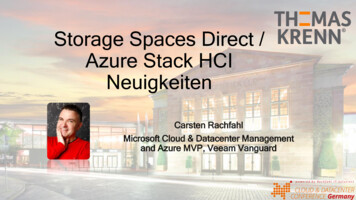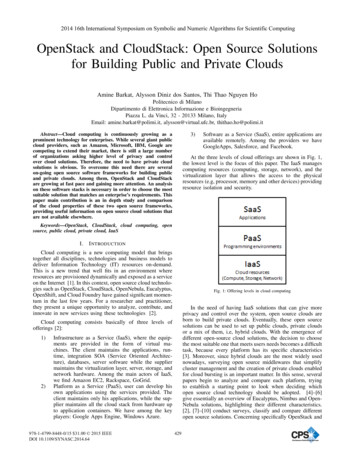
Transcription
2014 16th International Symposium on Symbolic and Numeric Algorithms for Scientific ComputingOpenStack and CloudStack: Open Source Solutionsfor Building Public and Private CloudsAmine Barkat, Alysson Diniz dos Santos, Thi Thao Nguyen HoPolitecnico di MilanoDipartimento di Elettronica Informazione e BioingegneriaPiazza L. da Vinci, 32 - 20133 Milano, ItalyEmail: amine.barkat@polimi.it, alysson@virtual.ufc.br, thithao.ho@polimi.it3)Abstract—Cloud computing is continuously growing as aprominent technology for enterprises. While several giant publiccloud providers, such as Amazon, Microsoft, IBM, Google arecompeting to extend their market, there is still a large numberof organizations asking higher level of privacy and controlover cloud solutions. Therefore, the need to have private cloudsolutions is obvious. To overcome this need there are severalon-going open source software frameworks for building publicand private clouds. Among them, OpenStack and CloudStackare growing at fast pace and gaining more attention. An analysison these software stacks is necessary in order to choose the mostsuitable solution that matches an enterprise’s requirements. Thispaper main contribution is an in depth study and comparisonof the cloud properties of these two open source frameworks,providing useful information on open source cloud solutions thatare not available elsewhere.Software as a Service (SaaS), entire applications areavailable remotely. Among the providers we haveGoogleApps, Salesforce, and Facebook.At the three levels of cloud offerings are shown in Fig. 1,the lowest level is the focus of this paper. The IaaS managescomputing resources (computing, storage, network), and thevirtualization layer that allows the access to the physicalresources (e.g, processor, memory and other devices) providingresource isolation and security.Keywords—OpenStack, CloudStack, cloud computing, opensource, public cloud, private cloud, IaaSI.I NTRODUCTIONCloud computing is a new computing model that bringstogether all disciplines, technologies and business models todeliver Information Technology (IT) resources on-demand.This is a new trend that well fits in an environment whereresources are provisioned dynamically and exposed as a serviceon the Internet [1]. In this context, open source cloud technologies such as OpenStack, CloudStack, OpenNebula, Eucalyptus,OpenShift, and Cloud Foundry have gained significant momentum in the last few years. For a researcher and practitioner,they present a unique opportunity to analyze, contribute, andinnovate in new services using these technologies [2].Fig. 1: Offering levels in cloud computingIn the need of having IaaS solutions that can give moreprivacy and control over the system, open source clouds areborn to build private clouds. Eventually, these open sourcesolutions can be used to set up public clouds, private cloudsor a mix of them, i.e, hybrid clouds. With the emergence ofdifferent open-source cloud solutions, the decision to choosethe most suitable one that meets users needs becomes a difficulttask, because every platform has its specific characteristics[3]. Moreover, since hybrid clouds are the most widely usednowadays, surveying open source middlewares that simplifycluster management and the creation of private clouds enabledfor cloud bursting is an important matter. In this sense, severalpapers begin to analyze and compare each platform, tryingto establish a starting point to look when deciding whichopen source cloud technology should be adopted. [4]–[6]give essentially an overview of Eucalyptus, Nimbus and OpenNebula solutions, highlighting their different characteristics.[2], [7]–[10] conduct surveys, classify and compare differentopen source solutions. Concerning specifically OpenStack andCloud computing consists basically of three levels ofofferings [2]:1)2)Infrastructure as a Service (IaaS), where the equipments are provided in the form of virtual machines. The client maintains the applications, runtime, integration SOA (Service Oriented Architecture), databases, server software while the suppliermaintains the virtualization layer, server, storage, andnetwork hardware. Among the main actors of IaaS,we find Amazon EC2, Rackspace, GoGrid.Platform as a Service (PaaS), user can develop hisown applications using the services provided. Theclient maintains only his applications, while the supplier maintains all the cloud stack from hardware upto application containers. We have among the keyplayers: Google Apps Engine, Windows Azure.978-1-4799-8448-0/15 31.00 2015 IEEEDOI 10.1109/SYNASC.2014.64427429
CloudStack, [11] presents briefly both solutions and doessome general features comparison, but enter in more detailsonly for OpenStack. Notwithstanding, several updates implemented recently to evolve and improve cloud softwares makethis kind of study quickly outdated.With this in mind, in this paper we present the generalfeatures of the newest versions of OpenStack and CloudStackand compare their general features and important properties,trying to provide useful information for users that need tochoose an open source cloud software.The paper is organized as follows: Section II describes thearchitecture of OpenStack and its important properties, SectionIII presents CloudStack, Section IV performs comparisonsbetween the two platforms. Conclusions are finally drawn inSection V.II.Fig. 2: OpenStack general architecture[13]. Compute is a distributed application that consists ofsix components: Nova-api, Message Queue, Nova-Compute,Nova-Network, Nova-Volume and Nova-Scheduler as shownin Fig. 3. Nova supports the complete life-cycles of an instancein the cloud, starting from the request to initialize a VM untilits termination. It follows this architecture:O PEN S TACKOpenStack is a cloud software that offers capability to control large pools of compute, storage and networking resources.It also empowers users providing on-demand resources [12].Starting from 2010, OpenStack was developed by RackspaceHosting and NASA [13] aimed to provide open source cloudsolution to build public or private clouds. The mission ofOpenStack is to enable any organization to create and offercloud computing services running on standard hardwares. Provisioned as open source solution, OpenStack is built keepingthese core principles in mind: (1) Open source: all codewill be released under the Apache 2.0 license allowing thecommunity to use it freely; (2) Open design: every 6 monthsthe development community will hold a design summit togather requirements and write specifications for the upcomingreleases; (3) Open development: maintains a publicly availablesource code repository through the entire development process;(4) Open community: produces a healthy, vibrant developmentand user community through an open and transparent process. Nova-api: accepts and responds to end user computeAPI calls. Beside providing its own OpenStack Compute API, Nova-api is compatible with Amazon EC2API, offering the potential to integrate with Amazoncloud services. It has another special Admin APIreserved for privileged users to perform administrativeactions. The orchestration activities such as runningan instance, or enforcing the policies such as quotachecks are initiated by this component. Nova-compute: is primarily a worker daemon that creates and terminates VM instances via hypervisor APIs.In order to do so, it accepts actions from the queueand performs system commands to fulfill them, whileupdating the database state accordingly. OpenStacksupports several standard hypervisors (listed in SectionIV) while keeping the openness that allows to interfaceother hypervisors through its standard library. Nova-volume: manages the creation, attaching anddetaching of persistent volumes to compute instances.There are two types of block devices supported for anVM instance: (1) Ephemeral Storage: is associated toa single unique instance. Its life-cycle exists togetherwith the instance life-cycle, which means when theinstance is terminated, data on this storage will alsobe deleted; (2) Volume Storage: is persistent andindependent from any particular instance. This storagecan be used as external disk device where the datastored on it still remain even when the instance isterminated. Nova-network: is a worker daemon that handlesnetwork-related tasks. It accepts and performs networking tasks from the queue to manipulate thenetwork such as setting up bridging interfaces orchanging iptable rules. Nova-schedule: handles the scheduling of VMs amongPMs. It takes a virtual machine instance request fromA. General ArchitectureAs in any cloud platform, the infrastructure underneathOpenStack is standard hardware, which can contain any piecesof physical devices such as servers, disks or network devices.In order to provide cloud services, OpenStack develops virtualization layers giving the abstract view of physical infrastructureto end users. These virtualization layers are built up by variouscomponents as described in Fig. 2. The OpenStack architectureconsists of three main components: Compute (Nova), Network(Quantum) and Storage (Swift). Beside these three pillars,OpenStack has been developing many other services, each ofthose designed to work together to provide a complete IaaSsolution. The integration of these services is facilitated throughpublic application programming interfaces (APIs) offered byeach service [13].In the following, the detailed description of each component is provided.1) Compute (Nova): Compute is the heart of OpenStack(codename is Nova and it is written in Python), which isthe computing fabric controller responsible for managing largenetworks of virtual machines (VMs), and eventually to properly schedule VMs among available physical machines (PMs)430428
Fig. 4: Networking component architecture [13]Fig. 3: Compute component architecture [13]can implement their own load balancing algorithms and plugit in the platform to achieve better workload control. Thearchitecture of Network component is shown in Fig. 4the queue and determines the physical host it shouldplace the instance on. While the scheduling algorithmscan be defined by users, Nova-schedule supports bydefault three algorithms: (1) Simple: attempts to findleast loaded host, (2) Chance: chooses random available host from service table, (3) Zone: picks randomhost from within an available zone. By allowingusers to define their own scheduling algorithms, thiscomponent is important for building fault tolerant andload-balanced system. Queue: provides a central hub for passing messagesbetween daemons. This is usually implemented withRabbitMQ today, but can support any AMPQ messagequeue. Database: stores most of the build-time and run-timestate of a cloud infrastructure. For example, it providesinformation of the instances that are available for useor in use, networks availability or storage information.Theoretically, OpenStack Nova can support any SQLbased database but the most widely used databasescurrently are sqlite3, MySQL and PostgreSQL.The Network architecture consists of four distinct physicaldata center networks:Given this architecture, all its components follow a sharednothing and messaging-based policy. Shared-nothing meansthat each component or each group of components can beinstalled on any server, in a distributed manner; while themessaging-based policy ensures the communication amongall components such as volume, network and scheduler isperformed via Queue Server. Management network: used for internal communication between OpenStack components. The IP addresses on this network should be reachable onlywithin the data center. Data network: used for VM data communicationwithin the cloud deployment. The IP addressing requirements of this network depend on the OpenStackNetworking plug-in in use. External network: used to provide VMs with Internetaccess in the deployment scenarios. The IP addresseson this network should be reachable by anyone on theInternet. API network: exposes all OpenStack APIs, includingthe OpenStack Networking API, to tenants. The IPaddresses on this network should be reachable byanyone on the Internet.3) Storage: The Storage component, one of three mainpillars of OpenStack architecture, is used to manage storageresources. OpenStack has support for both Object Storageand Block Storage, with many deployment options for each,depending on the use case.Object Storage (codename Swift) is a scalable objectstorage system. It provides a fully distributed, API-accessiblestorage platform that can be integrated directly into applications or used for backup, archiving, and data retention [13]. InObject Storage, data are written to multiple hardware devices,with the OpenStack software responsible for ensuring datareplication and integrity across clusters. Object storage clustersare scaled horizontally while adding new nodes. If a nodefails, OpenStack replicates its content from other active nodes.Because OpenStack uses software logic to ensure data replication and distribution, inexpensive commodity hard drivesand servers can be used instead of expensive equipments.Therefore, Object Storage is ideal for cost effective, scale-outstorage [13].2) Network (Quantum): Network is the key of cloudcomputing for several reasons: (1) Offered resources andservices must be accessible; (2) Address binding betweendifferent services is essential to support multi-tier applications;(3) Automatic network configuration capability is important,especially in scenarios where auto-scaling installations evolves.The OpenStack Networking component gives operators theability to leverage different network technologies to powertheir cloud networking through a rich set of APIs, multiplenetworking models (e.g, flat or private network) and flexibleplug-in architecture. Especially, the plug-in architecture - withthe plug-in agent - enables, not only capability of usingvarious network technologies, but also the ability to handleuser workloads. It means, at network level, that developers431429
Block Storage (codename Cinder), is the storage systemthat allows block devices to be exposed and connected tocompute instances for expanded storage, better performanceand integration with enterprise storage platforms, such asNetApp, Nexenta and SolidFire [13]. By managing the storageresources in blocks, Block Storage is appropriate for performance sensitive scenarios such as database storage, expandablefile systems, or providing a server with access to raw blocklevel storage.4) User interface - Dashboard: The OpenStack dashboardprovides to administrators and users a graphical interfaceto control their compute, storage and networking resources.Through the dashboard, administrators can also manage usersand set limits on resources access for each user. Live migration: is the process of moving a runningVM from one PM to another, while the VM is stillpowered-on. It is important to remember that memory,network connectivity and storage of the migrated VMare also transferred to the destination PM. This capability provides efficient online system maintenance,reconfiguration, load balancing and fault tolerance.OpenStack supports two types of live migration: (i)Shared storage based live migration, and (ii) Blocklive migration. The former supports live migrationscenarios where the source and destination hypervisorshave access to the shared storage, while the latter doesnot require shared storage. Load balancing: is the capability that allows to dynamically control the workloads among VMs or physical servers in order to achieve better performance.OpenStack supports load balancing at different scales.First of all, the supporting feature of live migrationhas enabled system administrators to distribute application workloads among physical servers by meansof adjusting VM placement. Moreover, it is possibleto control application workloads at VM level, serviceprovided by OpenStack Network layer, controlled byNetwork component. This component, with a flexibleplug-in architecture allows the development of runtime custom algorithms to distribute workloads amongVMs. Indeed, OpenStack has an on-going projectcalled Load Balancing as a Service (LBaaS) thatis aimed to provide load balancing service to endusers. This service has monitoring feature to determinewhether the VMs are available to handle user requestsand take routing decisions accordingly. Several routingpolicies are supported such as round robin (i.e, rotatesrequests evenly between multiple instances), sourceIP (i.e, requests from a unique source IP address areconsistently directed to the same instance) and leastconnections (i.e, allocate requests to the instance withthe least number of active connections). Fault tolerance: Within the flexible architecture ofOpenStack, fault tolerance can be handled at differentlevels. These levels depend on the way the IaaS systemis configured and deployed. At the VMs level, in orderto prevent failures, users can develop scheduling algorithms (besides the three already supported algorithmsby OpenStack) for placing the VMs that best fits tohis use cases. Some scheduling algorithms have beendesigned at the present time, such as: group scheduling(i.e, VMs that provide the same functionalities aregrouped and placed to separate PMs) and rescheduling(i.e, rescheduling of VMs from failed host to survivinghosts using live-migration). At storage or databaselevel, fault tolerance is achieved by using replicationand synchronization to ensure that a failure occurredat one device will not break the whole system. Availability: this property seeks to minimize system down time and data loss. In OpenStack, highavailability can be achieved through different setupsdepending on types of services, i.e, stateless or statefulservices. Stateless services can provide answer to arequest without requiring further information of other5) Shared Services: OpenStack Shared services are a setof several services that span across three pillars of compute,storage and networking, making it easy to perform cloudmanagement operations. These services include [13]: Identity Service (code-named Keystone): is the security service to protect resources access and usage.This service provides a central directory management,mapping users to OpenStack accessible services. Itacts as a common authentication system across thecloud operating system. It supports multiple formsof authentication including standard username andpassword credentials, token-based systems and AWSstyle logins. Image Service (code-named Glance): is the repositoryfor virtual disk and server images used by the VMs. InOpenStack, user can copy or snapshot a server imageand immediately store it away. Stored images can beused as a template to get new servers up and runningquickly and consistently. Telemetry Service: aggregates resources usage andperformance data of the services deployed in OpenStack cloud. This powerful capability provides visibility into the usage of the cloud infrastructure andallows cloud operators to view metrics globally orindividually. Orchestration Service: is a template-driven enginethat allows application developers to describe andautomate the deployment of the cloud infrastructureas well as detailed post-deployment activities ofinfrastructure, services and applications. Database Service: allows users to quickly and easilyutilize the features of a relational database. Cloudusers and database administrators can provision andmanage multiple database instances as needed.B. PropertiesProvisioned as IaaS, OpenStack is built following an openphilosophy: avoid technology lock-ins by not requiring specifictechnologies and providing user freedom to choose the best slotthat matches its needs [13]. In this section, we will analyzesome important properties of OpenStack.432430
services or historical data. OpenStack stateless services include nova-api, nova-scheduler, etc. For theseservices, high availability is achieved by providingredundant insta
Keywords—OpenStack, CloudStack, cloud computing, open source, public cloud, private cloud, IaaS I. INTRODUCTION Cloud computing is a new computing model that brings together all disciplines, technologies and business models to
